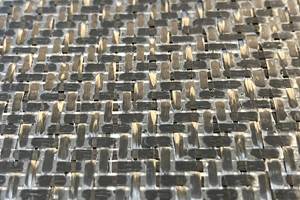Tensile testing composites: Simple concept, difficult in practice
Dr. Daniel O. Adams, professor of mechanical engineering and director of the Composite Mechanics Laboratory at the University of Utah, and the vice president of Wyoming Test Fixtures Inc. (Salt Lake City, UT, US), takes over for his father, Dr. Donald F. Adams, as the anchor writer in CompositesWorld magazine's revamped CW Design and Testing column. First subject? The challenges of tensile testing unidirectional composites.
Among the most common properties reported for fiber-reinforced polymers are those obtained from tensile testing of a unidirectional (UD) composite in the fiber direction. These properties include modulus of elasticity, Poisson’s ratio, tensile strength, and ultimate tensile strain. The tensile test that measures these properties is, on the face of it, very simple: A thin strip of a UD composite is placed into the wedge grips of a mechanical testing machine and loaded slowly in tension. To determine the modulus of elasticity and Poisson’s ratio, strains are measured during the initial stage of the test, using strain gages or extensometers. Loading continues to ultimate failure, the point at which tensile strength and ultimate tensile strain are determined. In practice, however, obtaining the desired results can be rather difficult.
Measuring the modulus of elasticity and Poisson’s ratio is not the problem. These properties are measured at load levels well below the point of failure, typically corresponding to strain levels between 0.1% and 0.3%. The tensile strength and ultimate tensile strain values are the challenges, and they become more difficult to obtain as the specimen’s tensile strength increases.
Why the difficulty? For starters, it requires a relatively large load to produce specimen failure, and it’s no easy task to cause failure in the test section before failure occurs elsewhere. The specimen, therefore, must be designed in such a way that stress during the test will be greater in the central test section than in the load-introduction regions on each end. To do so, the cross-sectional area in the central section must be smaller than the area at each end. For metals and unreinforced plastics, the width of the specimen is gradually reduced leading into the central test section (see Fig. 1, at left). Although width tapering, or “dog-boning,” appears to be an attractive option, in the case of UD composites, axial splitting of the specimen often occurs well before ultimate failure, effectively producing an untapered specimen. These axial cracks result from the relatively low shear strength of the UD composite material coupled with relatively high shear stresses in these regions.
Although width tapering isn’t an option, producing a specimen with greater thickness at each end is an attractive alternative. Rather than reduce the thickness of the composite specimen in the test section, the thickness at the ends is increased with bonded tabs (see Fig. 2, at left). Glass fabric/epoxy printed circuit board material is commonly used for tabbing for several reasons, including its commercial availably at low cost, its relatively low stiffness and its high strength. Further, the bonded tabbing strips also can be machined in the same manner as the tested composite material when individual specimens are cut from a test panel. Bonded tabs not only prevent axial cracking but also protect the surface of the composite specimen from direct contact with the serrated grip faces, which could cut or tear it during loading.
When a tabbed tensile specimen is tested, the load is introduced through shear at the gripped tab surfaces. The tabbing material and the adhesive bond must have shear strength adequate to transfer the load into the composite to produce failure. However, it’s not enough to simply produce specimen failure. A “good” tensile test is one that measures the fullest extent of the composite material’s tensile strength during the test. That requires a uniform distribution of axial stress throughout the composite test, or gage, section between the tabs. Toward that end, a tabbing configuration must be designed to minimize the stress concentrations produced in the tab termination region. Although there are several geometric and material parameters that can be used to design a tabbed tensile specimen that minimizes stress concentrations1, the following four parameters are, perhaps, the most important.
Tab taper angle: An effective means of minimizing the stress concentration is to taper the tab thickness, effectively “feathering” the load into the specimen gage section. Although it’s tempting to use a very small tab taper angle to minimize stress concentrations, there are practical limits. Out-of-plane peel stresses produced at the tip of the tapered tab increase as the taper angle decreases, leading to failure of the adhesive bond. This design consideration is often overlooked, and it is not uncommon for the tips of the tabs to debond from the tensile specimen prior to ultimate failure — a highly undesirable outcome because it effectively eliminates the benefits of the tab taper. Tab debonding can be detected as audible “pings” and, sometimes, observed under low magnification during testing. The choice of a tab taper angle involves a compromise between minimizing stress concentrations and preventing tab disbonding. ASTM D 30392 suggests a tab taper angle of 7º-10º when testing 0º UD composites with wedge grips. However, the taper angle should be increased or the adhesive bond strength improved if debonding of the tab tips is detected.
Tab length: The minimum tab length depends on the load required for specimen failure and the shear strength of the adhesive. An increase in tab length reduces the stress concentration in the tab termination region, but reductions are minimal beyond a tab length of ~40 mm. The tab’s entire untapered length should be gripped during the test to minimize peel stresses at the tab termination. Therefore, use the longest tab length permitted by the test grips, with a minimum untapered length of 40 mm.
Adhesive layer thickness: A thicker adhesive bondline can reduce the stress concentration at the tab termination because the adhesive is more compliant than the tab and composite material. Epoxy adhesives that yield high strength in thicker bondlines are available. Although the reduction in stress concentration as bondline thickness increases is less pronounced when using tapered tabs, increasing the adhesive thickness to 1-2 mm yields a justifiable reduction.
Composite specimen thickness: This parameter is often overlooked, but the load that must be introduced to produce a gage section failure decreases as the specimen thickness decreases. In fact, decreasing the thickness of the composite specimen, when possible, is the most effective means of mitigating the previously discussed problems with tabbed tensile specimens.
Although difficulties in obtaining accurate strength measurements from UD composite tensile testing often can be addressed through improved specimen design, careful fabrication of tabbed specimens is also important and cannot be overlooked. But the word of encouragement in all this is that the difficulties diminish with decreasing specimen strength. Therefore, those who can successfully perform tensile tests on 0º UD composites can likely do the same with any other fiber orientation or layup.
References
1ASTM D3039/D3039M-14, “Standard Test Method for Tensile Properties of Polymer Matrix Composite Materials,” ASTM International (W. Conshohocken, PA, US), 2014.
2D.O. Adams and D.F. Adams, “Tabbing Guide for Composite Test Specimens,” Federal Aviation Administration Report No. DOT/FAA/AR-02/106, October 2002 (online at http://www.tc.faa.gov/its/worldpac/techrpt/ar02-106.pdf).
Related Content
Composite resins price change report
CW’s running summary of resin price change announcements from major material suppliers that serve the composites manufacturing industry.
Read MorePontacol thermoplastic adhesive films are well-suited for composite preforms
Copolyester- and copolyamide-based adhesive films eliminate the need for sewing threads or binders when stacking laminates while improving the final part’s mechanical properties.
Read MoreHenkel releases digital tool for end-to-end product transparency
Quick and comprehensive carbon footprint reporting for about 58,000 of Henkel’s adhesives, sealants and functional coatings has been certified by TÜV Rheinland.
Read MorePittsburgh engineers receive $259K DARPA award for mussel-inspired underwater adhesion
The proposed META GLUE takes inspiration from hydrogels, liquid crystal elastomers and mussels’ natural bioadhesives to develop highly architected synthetic systems.
Read MoreRead Next
VIDEO: High-volume processing for fiberglass components
Cannon Ergos, a company specializing in high-ton presses and equipment for composites fabrication and plastics processing, displayed automotive and industrial components at CAMX 2024.
Read MoreAll-recycled, needle-punched nonwoven CFRP slashes carbon footprint of Formula 2 seat
Dallara and Tenowo collaborate to produce a race-ready Formula 2 seat using recycled carbon fiber, reducing CO2 emissions by 97.5% compared to virgin materials.
Read MoreDeveloping bonded composite repair for ships, offshore units
Bureau Veritas and industry partners issue guidelines and pave the way for certification via StrengthBond Offshore project.
Read More






















